Merthyr Tydfil County Borough
Merthyr Tydfil County Borough (/ˈmɜːrθər ˈtɪdvɪl/;[1] Welsh: Merthyr Tudful [ˈmɛrθər ˈtɨːdvɨ̞l]) has been one of the 22 unitary authorities in Wales since 1 April 1996 (though the area was originally granted county borough status in 1908). Merthyr Tydfil County Borough today has a population of 60,183 (mid-2018 estimate).[2] It is located in the historic county of Glamorgan and takes its name from Merthyr Tydfil town. The County Borough consists of the northern part of the Taff Valley and the smaller neighbouring Taff Bargoed Valley. It borders the counties of Rhondda Cynon Taf and Caerphilly county borough.
 | |
| Geography | |
| Area - Total - Water |
Ranked 21st 111 km² 17% |
|---|---|
| Admin HQ | Merthyr Tydfil |
| ISO 3166-2 | GB-MTY |
| ONS code | 00PH (ONS) W06000024 (GSS) |
| Demographics | |
| Population: - Total (2017) - Density |
Ranked 22nd 60,183 Ranked 9th 540 / km² |
| Ethnicity | 99.6% White. |
| Welsh language - Any skills |
Ranked 15th 17.7% |
| Politics | |
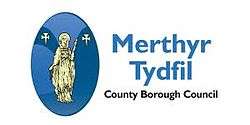 | |
| Control | |
County Borough Status
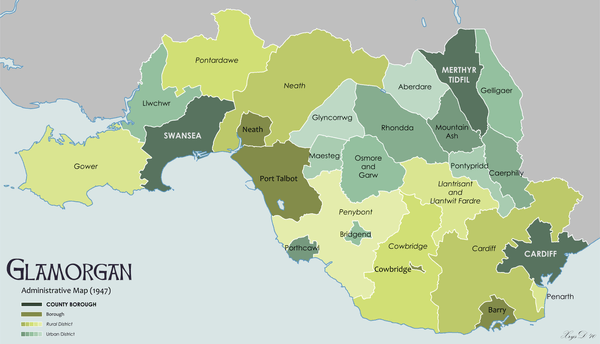
Following the industrial revolution and growth, initially from the iron and steel industry, in Dowlais, Cyfarthfa, Penydarren and Plymouth, and then later from the coal-mining industry in Aberfan, Treharris and Bedlinog the area was originally granted county borough status in 1908,[3] despite protests from the southern part of the borough, where it was claimed that links were stronger with Pontypridd.[4][5] In 1935, a Royal Commission argued that Merthyr Tydfil County Borough, then heavily burdened by the cost of maintaining many unemployed people, should be abolished and merged with Glamorgan. The county council refused the proposal.[5] The current borough boundaries date back to 1974, when Merthyr Tydfil became a local government district in the administrative county of Mid Glamorgan. It reverted to a county borough again on 1 April 1996.
Government
Merthyr Tydfil County Borough Council is the governing body for the area. It consists of 33 councillors representing 11 wards. During the local government elections of 1 May 2008, the long-ruling Welsh Labour Party lost its majority control of Merthyr Tydfil County Borough Council as a cohort of independents took seats and the Liberal Democrats also made a significant breakthrough. However the Labour group gained back majority control in the following election on 3 May 2012.

The current Member of Parliament for the Merthyr Tydfil and Rhymney constituency is Gerald Jones MP, while the Welsh Assembly member is Dawn Bowden AM.
Additionally, the Bedlinog Ward in the Merthyr Tydfil County Borough, which covers the villages of Trelewis and Bedlinog in the neighbouring Taff Bargoed Valley, is also governed by Bedlinog Community Council, which consists of nine elected members, and whose powers and responsibilities cover the two villages within its area. The Ward is the only electoral area within the Merthyr Tydfil County Borough Council area with its own Council. The Council was created in 1974 by the former Gelligaer Urban District Council prior to its abolition and the subsequent transfer of Trelewis and Bedlinog into the Merthyr administrative area upon local government reorganisation in that year, to which most people in Bedlinog and Trelewis were opposed.
History
Pre-industrial Merthyr
What is now Merthyr Tydfil town centre was originally little more than a village. An ironworks existed in the parish in the Elizabethan period, but it did not survive beyond the early 1640s at the latest. In 1754, it was recorded that the valley was almost entirely populated by shepherds. Farm produce was traded at a number of markets and fairs, notably the Waun Fair above Dowlais.[3]
The Industrial Revolution
Influence and growth of iron industry
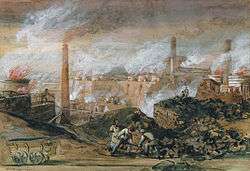
What is now Merthyr Tydfil County Borough was situated close to reserves of iron ore, coal, limestone and water, making it an ideal site for ironworks. Small-scale iron working and coal mining had been carried out at some places in South Wales since the Tudor period, but in the wake of the Industrial revolution the demand for iron led to the rapid expansion of Merthyr's iron operations in the northern half of the County Borough. The Dowlais Ironworks was founded by what would become the Dowlais Iron Company in 1759, making it the first major works in the area. It was followed in 1765 by the Cyfarthfa Ironworks. The Plymouth Ironworks were initially in the same ownership as Cyfarthfa, but passed after the death of Anthony Bacon to Richard Hill in 1788. The fourth ironworks was Penydarren built by Francis Homfray and Samuel Homfray after 1784.
The demand for iron was fuelled by the Royal Navy, who needed cannon for their ships, and later by the railways. In 1802, Admiral Lord Nelson visited Merthyr to witness cannon being made.
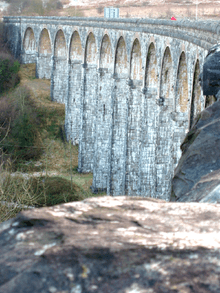
Several railway companies established routes that linked Merthyr with coastal ports or other parts of Britain. They included the Brecon and Merthyr Railway, Vale of Neath Railway, Taff Vale Railway and Great Western Railway. They often shared routes to enable access to coal mines and ironworks through rugged country, which presented great engineering challenges. In 1804, the world's first railway steam locomotive, "The Iron Horse", developed by the Cornish engineer Richard Trevithick, pulled 10 tons of iron on the newly constructed Merthyr Tramway from Penydarren to Abercynon.[6][7] A replica of this now resides in the National Waterfront Museum in Swansea. The tramway passed through what is arguably the oldest railway tunnel in the world, part of which can still be seen alongside Pentrebach Road at the lower end of the town.
The 1801 census recorded the population of Merthyr as 7705, the most populous parish in Wales (however, the built-up area of Swansea, covering several parishes, then exceeded 10,000). By 1851 Merthyr had overtaken Swansea to become the largest town in Wales with 46,378 inhabitants. By this time, Irish immigrants made up 10% of the local population, and there were substantial numbers of English, together with some Spaniards and Italians.[3] A Jewish community was established some time after 1841, and by 1851, they were able to establish a small prayer hall. The charming Merthyr Synagogue was consecrated in 1875 and a cemetery at Cefn-Coed was established in the 1860s.
During the first few decades of the 19th century, the ironworks at Dowlais and Cyfarthfa continued to expand and at their peak were the most productive ironworks in the world. 50,000 tons of rails left just one ironworks in 1844, to enable expansion of railways across Russia to Siberia. At its peak, the Dowlais Iron Company operated 18 blast furnaces and employed 7,300 people, and by 1857 had constructed the world's most powerful rolling mill. The companies were mainly owned by two dynasties, the Guest and Crawshay families. One of the famous members of the Guest family was Lady Charlotte Guest who translated the Mabinogion into English from its original Welsh. The families also supported the establishment of schools for their workers.
Thomas Carlyle visited Merthyr town in 1850, writing that it was filled with such "unguided, hard-worked, fierce, and miserable-looking sons of Adam I never saw before. Ah me ! It is like a vision of Hell, and will never leave me, that of these poor creatures broiling, all in sweat and dirt, amid their furnaces, pits, and rolling mills."[8]
The Merthyr Rising
The Merthyr Rising of 1831 were precipitated by a combination of the ruthless collection of debts, frequent wage reductions when the value of iron periodically fell, and the imposition of truck shops. Some workers were paid in specially minted coins or credit notes, known as "truck" which could only be exchanged at shops owned by their employers. Many of the workers objected to both the price and quality of the goods sold in these shops.
Some 7,000 to 10,000 workers marched and, for four days, magistrates and ironmasters were under siege in the Castle Hotel, and the protesters effectively controlled Merthyr.[3] Soldiers, called in from Brecon, clashed with the rioters, and several on both sides were killed. Despite the hope that they could negotiate with the owners, the skilled workers lost control of the movement.
Several of the supposed leaders of the riots were arrested. One of them, Richard Lewis, popularly known as Dic Penderyn, was hanged for the crime of stabbing a soldier named Donald Black in the leg. Lewis became known as the first local working-class martyr.
Alexander Cordell's low-brow novel The Fire People is set in this period. A more serious political history of these events, The Merthyr Rising was written by the Merthyr-born Marxist writer Professor Gwyn A. Williams in 1978.
The rising helped create the momentum that led to the Reform Act. The Chartism movement, which did not consider these reforms extensive enough, was subsequently active in Merthyr.
The decline of coal and iron
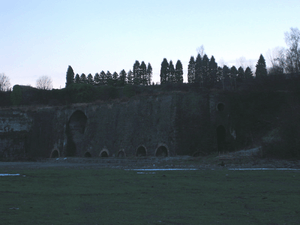
The steel and coal industries began to decline after World War I, and by the 1930s, they had all closed. By 1932, more than 80% of men in Dowlais were unemployed; Merthyr experienced an out-migration of 27,000 people in the 1920s and 1930s, and a Royal Commission recommended that the town's county borough status should be abolished.[3] The fortunes of Merthyr revived temporarily during World War II, as war-related industry was established in the area. In the post-war years the local economy became increasingly reliant on light manufacturing, often providing employment for women rather than men.
In 1987, the iron foundry, all that remained of the former Dowlais ironworks, finally closed, marking the end of 228 years continuous production on one site.
Post-Second World War
Immediately following the Second World War, several large companies set up in Merthyr. In October 1948 the American-owned Hoover Company opened a large washing machine factory and depot in the village of Pentrebach, a few miles south of the town. The factory was purpose-built to manufacture the Hoover Electric Washing Machine, and at one point Hoover was the largest employer in the borough. Later the Sinclair C5 was built the same factory.

Several other companies built factories, including the aviation components company Teddington Aircraft Controls, which opened in 1946. The Teddington factory closed in the early 1970s. The local Merthyr Tydfil Institute for the Blind, founded in 1923, remains the oldest active manufacturer in the town.[9]
The Gurnos housing estate was established by Merthyr Tydfil Council in the early 1950s and expanded over many years. Cyfarthfa, the former home of the ironmaster William Crawshay II, an opulent mock-castle, is now a museum. It houses a number of paintings of the town, a large collection of artefacts from the town's Industrial Revolution period, and a notable collection of Egyptian tomb artefacts, including several sarcophagi.
On 21 October 1966 a colliery tip slid down a mountain at Aberfan, 4 miles (6.4 km) south of Merthyr, covering the village school and causing the Aberfan disaster.
In 1992, while testing a new angina treatment in Merthyr Tydfil, researchers discovered that the new drug had erection-stimulating side effects for some of the healthy volunteers in the trial study. This discovery would go on to form the basis for Viagra.[10]
In 2006 inventor Howard Stapleton, based in Merthyr Tydfil, developed the technology that has given rise to the recent mosquitotone or Teen Buzz phenomenon.[11]
Open cast mining
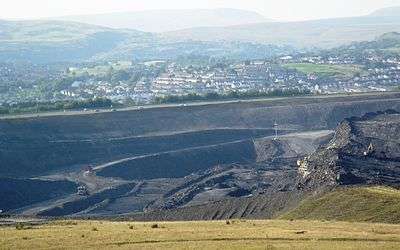
In 2006, a large open cast coal mine, which will extract 10 million tonnes of coal over 15 years, was authorised just east of Dowlais as part of the Ffos-y-fran Opencast mine.
Industrial legacy
Merthyr Tydfil has a long and varied industrial heritage, and was one of the seats of the industrial revolution. Since the end of the Second World War, much of this has declined, with the closure of long-established coal mining collieries, and both steel and ironworks. Despite recent improvements, some parts of the County Borough remain economically disadvantaged, and there is a significant proportion of the community who are long-term unemployed.
In Britain today, Merthyr Tydfil:
- Ranks 13th worst for economic activity
- Ranks 13th worst for life expectancy: women live on average 79.1 years, and men 75.5. This is lower than the average for England but better than the Scottish and north of England averages[12]
- Has 30% of the population suffering from a limiting long-term illness.
A Channel 4 programme rated Merthyr Tydfil as the third worst place to live in Britain in 2006 following areas of London.[13][14][15]
However, in the 2007 edition of the same programme, Merthyr had `improved` to fifth worst place to live.[16]
Culture
Merthyr Tydfil County Borough is home to several established choirs who perform regularly in the local area and throughout the rest of the world. They include Ynysowen Male Choir, Treharris Male Voice Choir, Dowlais Male Voice Choir, Merthyr Tydfil Ladies Choir, Cantorion Cyfarthfa, and the mixed-voice choir Con Voce. Merthyr Tydfil County Borough has held many cultural events. Local poets and writers hold poetry evenings in the town, and music festivals are organised at Cyfarthfa Castle and Park. With this in mind, Menter Iaith Merthyr Tudful (The Merthyr Tydfil Welsh Language Initiative) have successfully transformed the Zoar Chapel and the adjacent vestry building in Pontmorlais into a community arts venue; Canolfan Soar and Theatr Soar, who now run a whole programme of performance events and activities through both the Welsh and English languages, together with a caffe and book shop, specialising in local interest and Welsh language books and CDs.[17] Also on Pontmorlais Merthyr Tydfil Housing Association have recently been successful in a number of funding bids to develop the Old Town Hall into a new cultural centre, working in partnership with Canolfan a Theatr Soar to turn the Pontmorlais area into a cultural quarter for Merthyr Tydfil. The Old Town Hall facility is to be launched on Saint David's Day 2014, using references to the 1831 Merthyr Rising and the building's red bricks, the venue is to be marketed as REDHOUSE - Hen Neuadd Y Dref / Old Town Hall.[18] Merthyr Tydfil College's Myfanwy Theatre also holds occasional professional performances and provides opportunity for students to perform dance, musicals, plays, and instrumental and vocal concerts, and where students work out with some of the best in the business, including members of the Welsh National Opera.
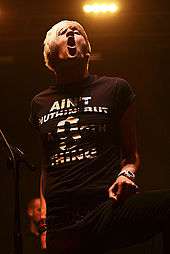
Merthyr has several historical and heritage groups:
The Merthyr Tydfil Heritage Regeneration Trust, which has as its aim - "To preserve for the benefit of the residents of Merthyr Tydfil and of the Nation at large whatever of the Historical, Architectural and Constructional Heritage may exist in and around Merthyr Tydfil in the form of buildings and artefacts of particular beauty or of Historical, Architectural or Constructional interest and also to improve, conserve and protect the environment thereto."[19]
The Merthyr Tydfil Historical Society, which has as its aim - "To advance the education of the public by promoting the study of the local history and architecture of Merthyr Tydfil".[20]
The Merthyr Tydfil Museum and Heritage Groups, which has as its aim - "To advance the education of the public by the promotion, support and improvement of the Heritage of Merthyr Tydfil and its Museums."[21]
Merthyr Tydfil's Central Library, which is in a prominent position in the centre of the town, is a Carnegie library.
Merthyr Tydfil hosted the National Eisteddfod in 1881 and 1901 and the national Urdd Gobaith Cymru Eisteddfod in 1987.
Since 2005 a free multi-cultural festival, Global Village, has been held in Cyfarthfa Park, featuring music, dance, literature, arts and crafts, food and information stalls, workshops and performances from cultures from across the globe, including African music and dance, Thai dance, Japanese Taiko drumming, Native American Hoop Dance, didgeridoo music, Welsh harp, Irish folk music, Welsh folk dance, Indian dance and music, Portuguese Fado singing and much more.[22]
Merthyr, like nearby Aberdare, is also known for its thriving music scene. The county borough has produced several bands which have achieved national success, including The Blackout from Heolgerrig and Midasuno from Troedyrhiw. Since 2011 Cyfarthfa Park has now also become the home of the Merthyr Rock Festival and from 2009 until 2012 a weekend Welsh language music festival, Bedroc was held at Bedlinog featuring major Welsh language acts, together with local artists including Welsh language activist Jamie Bevan with bands Y Betti Galws and Y Gweddillion (The Remnants).[23][24]
Tourism
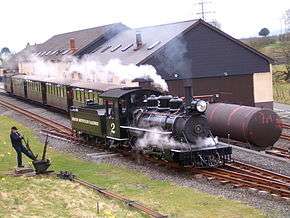
The County Borough is located in a South Wales Valleys environment overlapping into the south of the Brecon Beacons National Park, and this, along with the area's rich history, means it has huge potential for tourism in Wales. National Cycle Route 8 passes through the County Borough. The Brecon Mountain Railway is located within the Brecon Beacons National Park, in the north of Merthyr Tydfil County Borough, starting at Pant and currently running to Dolygaer (though there are plans to extend even further). The Fforest Fawr Geopark, designated in 2005 in respect of the area's outstanding geological and cultural heritage, also falls within the northern border of Merthyr Tydfil County Borough. The borough has recently been awarded European Funding as part of the Interreg Collabor8 project and will be working in partnership with the Brecon Beacons National Park Authority to promote the region across Europe.
The Taff Bargoed Valley is increasingly becoming an area for outdoor activities and is home to Parc Taff Bargoed and the Summit Centre (formerly Welsh International Climbing Centre). Settlements of interest include Bedlinog, Quakers Yard, Nelson, Trelewis, and Treharris.
Transport
Railways
Regular rail services operate from Merthyr Tydfil railway station, through stations at Pentrebach, Troedyrhiw, Merthyr Vale and Quakers Yard in the County Borough to Cardiff Queen Street and Cardiff Central. Public transport links to Cardiff are being improved.[27]
Employment
Modern-day Merthyr relies on a combination of public sector and manufacturing and service sector companies to provide employment. The Welsh Assembly Government has recently opened a major office just outside the town centre[28] near a large telecommunications call centre (T-Mobile). Hoover (now part of the Candy Group) has its Registered Office in the town and remained a major employer until it transferred production abroad in March 2009, resulting in the loss of 337 jobs after the closure of its factory.
Sports and leisure
- Cricket
Hills Plymouth Cricket Club is the oldest established Cricket club in the Merthyr Tydfil County Borough, based in Pentrebach. Penydarren Country XI Cricket Club was founded in 1971 and currently play at the ICI Rifle Fields Ground. The club's most successful players being Paul Crump & Kerry Morgan.
- Boxing
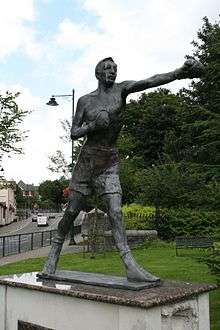
Merthyr is particularly known for its boxers, both amateur and professional. Some famous professional pugilists from the town include: Johnny Owen, Howard Winstone and Eddie Thomas.
- Football
In sporting terms, Merthyr is widely recognised for the town's football team, Merthyr Town. 'The Martyrs' currently compete in the Evostick Southern Football League and play home games at Penydarren Park. The club had their proudest moment in 1987, when having won the Welsh Cup and qualified for the European Cup Winners Cup, they beat Italian football team Atalanta 2–1 at Penydarren Park.
The town was once home to a fully professional Football League club, Merthyr Town F.C., which folded in the 1930s and Merthyr Tydfil AFC were founded in 1945. The year of 2008 marked the centenary of football having been played at Penydarren Park (1908 – 2008). After going into liquidation in 2010, the club switched grounds to. Treharris Athletic Western F.C. play at the Athletic Ground in Treharris. The club play in the Welsh Football League Division Two.[29]
- Golf
Merthyr Tydfil Golf Club is situated on the southeastern slopes of Cefn Cil Sanws, a rough gritstone and limestone hill in the north-west of the County Borough. It is one of the highest golf courses in Britain. Morlais Castle Golf Club is situated adjacent to the ruins of Morlais Castle on Morlais Hill, approximately 2 km to the east and at about the same altitude.
- Rugby union
Merthyr RFC, is known as 'the Ironmen'. Merthyr RFC was one of the twelve founding clubs of the Welsh Rugby Union in 1881. Bedlinog RFC, known as 'the Foxes' and Dowlais RFC were formed in the 1970s (though there were earlier versions of both).
- Rugby league
Merthyr Tydfil is home to the Tydfil Wildcats Rugby League team who played at The Cage in Troedyrhiw until September 2010. For 2011 the club is hosted by Dowlais RFC. Merthyr Tydfil was one of the first rugby league sides formed in Wales in 1907 and notably beat the first touring Australian side in 1908.
Education
Merthyr Tydfil College is the main further education provider in the area.
Notable people
- See Category:People from Merthyr Tydfil County Borough
Among those born in Merthyr Tydfil County Borough are:
- Gareth Abraham — professional footballer[30]
- Laura Ashley — fashion designer and retailer[31]
- Des Barry — author
- Mario Basini — journalist, broadcaster and author
- Barrie Bates — professional darts player
- William Berry, 1st Viscount Camrose — newspaper proprietor, and his brothers Seymour Berry (Baron Buckland) and Gomer Berry, 1st Viscount Kemsley
- Jamie Bevan — Welsh language activist[32]
- The Blackout — post-hardcore band
- Kizzy Crawford — singer songwriter
- Nathan Craze — professional ice hockey goaltender[33]
- Lloyd Daniels — singer; X Factor finalist
- David Davies — international footballer
- Ivor Davies — artist
- Richard Davies — actor
- Thomas Nathaniel Davies — artist
- Foreign Legion — street punk band
- Kevin Gall — professional footballer
- Sir Samuel Griffith — Australian politician
- Richard Harrington — actor
- John Hughes — businessman
- Robert Alwyn Hughes — artist
- Ciaran Jenkins — broadcaster and journalist
- Glyn Jones — poet
- Michael 'Micky' Jones (1942 – 10 March 2010) — guitarist, singer and songwriter with The Bystanders and Man
- John Edward Jones (governor) — American politician and the eighth Governor of Nevada
- William Ifor Jones — American conductor and organist
- Julien Macdonald — fashion designer
- Philip Madoc — actor
- Midasuno — alternative rock band
- Owen Money — comedian and singer
- Leslie Norris — poet
- Idloes Owen — singer, composer and conductor; founder of the Welsh National Opera
- Johnny Owen — boxer
- Jonny Owen — actor, broadcaster and producer
- Joseph Parry — composer
- Gustavius Payne — artist (painter)
- Mark Pembridge — Wales international football player
- Robert Sidoli — Welsh rugby international
- Rob Spragg — aka Larry Love — frontman (lead vocals) for Alabama 3
- Steve Speirs — actor
- Eddie Thomas — boxer
- Malcolm Vaughan — singer/actor
- Howard Winstone — boxer
- Gwyn A. Williams — historian and author
- Penry Williams — artist (painter)
- Trefor Jenkins - human geneticist and medical ethicist
Other notable residents include, and have included, poet and author Mike Jenkins (his son Ceiran mentioned above) and daughter Plaid Cymru politician Bethan Jenkins, poet, journalist and Welsh Nationalist Harri Webb, General Secretary of the PCS trade union Mark Serwotka, poet, author and Welsh language activist Meic Stephens, poet, author and journalist Grahame Davies. Sam Hughes began his career as a noted player of the ophicleide in the Cyfarthfa Brass Band. One of the first two Labour MPs to be elected to parliament was the Scot Keir Hardie, who was elected by the Merthyr Tydfil constituency. Notable descendants of Merthyr Tydfil include the singer-songwriter Katell Keineg, whose mother is a native of Merthyr Tydfil, also the "Chariots of Fire" athlete Harold Abrahams' mother Esther Isaacs and the grandfather of Rolf Harris both came from Merthyr Tydfil. The 1970s juvenile group The Osmonds are of Welsh descent and have traced their ancestry to Merthyr Tydfil.[34] A number of artists and poets, including Cedric Morris, Heinz Koppel, Arthur Giardelli and Esther Grainger, were also drawn to Merthyr town and Dowlais during the 1940s, establishing the Merthyr Tydfil Educational settlement and the Dowlais Art Centre/Settlement.[35][36]
References in art and literature
- Rachel Trezise's 2007 book Dial 'M' for Merthyr (Parthian) follows Troed-y-rhiw rock band Midasuno on tour.[37]
- Fierce Panda also released a compilation CD called Dial M for Merthyr in 1997 featuring Welsh rock bands including Manic Street Preachers, Catatonia, Stereophonics and 60 Ft. Dolls. Boxer Johnny Owen is pictured running over the hill tops on the cover.[38]
- Horatio Clare's retelling of one of the Mabinogion tales, The Prince's Pen (Seren) refers to Merthyr Tydfil as being "declared an insurgent zone", and that people would refer to "'what happened at Merthyr' for years to follow".[39]
- In the third episode of the 1978 BBC sitcom Going Straight Merthyr Tydfil is referred to as having, ".. more pubs.. than anywhere else in Britain, and they're all shut Sundays."
- In author Jasper Fforde's Thursday Next series (set in an alternate history), begun in 2001, Merthyr Tydfil is the capital of an independent People's Republic of Wales.
- Australian poet Les Murray references his experiences in the town in his poem "Vindaloo in Merthyr Tydfil".
- Canadian songwriter Jane Siberry uses "the slags of Merthyr Tydfil" as an image in her song "You Don't Need", from the 1984 album No Borders Here.
Twinnings
- Clichy, Hauts-de-Seine, France, Since 1980 [40][41]
See also
- List of places in Merthyr Tydfil - a list of settlements
- Pont-y-Cafnau - the world's earliest surviving iron railway bridge
Notes
- Wells, John (12 January 2010). "Merthyr". John Wells's phonetic blog. Retrieved 5 March 2010.
- "Estimates of the population for the UK, England and Wales, Scotland and Northern Ireland". ONS. Retrieved 9 July 2019.
- The Welsh Academy Encyclopedia of Wales. Cardiff: University of Wales Press 2008.
- "A Vision of Britain through Time: Relationships/Unit History of Merthyr Tudful". Visionofbritain.org.uk. Archived from the original on 5 December 2007. Retrieved 19 February 2012.
- Davies (2008), p.173
- "Pembrokeshire-wales.info". Archived from the original on 11 April 2013. Retrieved 12 June 2013.
- Trevithick2004.co.uk
- James Anthony Froude, Thomas Carlyle: A History of his Life in London 1834-1881, Longmans, vol 2, 1855, p. 52.
- MTIB.co.uk
- Staff (4 September 2007). "Blue wonder: Happy birthday Viagra". independent.co.uk. Retrieved 28 February 2012.
- "Firm's ringtone 'next Crazy Frog'". BBC News. 14 June 2006. Retrieved 12 May 2010.
- "WebPage". Archived from the original on 8 October 2011. Retrieved 12 June 2013.
- Merthyr Tydfil: Best and Worst Places to Live in the UK 2006 from channel4.com
- 'Third worst place in UK' — but Valleys town disputes claims — icWales
- "Ten reasons to love 'worst town'". BBC News. 10 August 2005. Retrieved 12 May 2010.
- Channel4.com
- http://theatrsoar.com/
- http://www.redhousecymru.com/
- "MTHT.co.uk". Archived from the original on 3 June 2013. Retrieved 12 June 2013.
- MTHS.co.uk
- "MTHT.co.uk". Archived from the original on 3 June 2013. Retrieved 12 June 2013.
- http://merthyrtydfilglobalvillage.org.uk/
- https://www.youtube.com/watch?v=6EWcsQJhzRs
- http://maes-e.com/viewtopic.php?f=32&t=29304
- "Merthyr named UK's house hotspot". BBC News. 16 October 2004. Retrieved 12 May 2010.
- "House price boom as market grows". BBC News. 8 August 2006. Retrieved 12 May 2010.
- "£19m for Merthyr-Cardiff trains". BBC News. 8 February 2007. Retrieved 12 May 2010.
- "Assembly building in valleys town". BBC News. 30 November 2006. Retrieved 12 May 2010.
- "Treharris Athletic Western". Clubs in membership of Division Two 2011–12. Welsh Football League. Archived from the original on 20 July 2011. Retrieved 3 September 2011.
- "Gareth Abraham". Post War English & Scottish Football League A - Z Player's Database. Retrieved 29 September 2012.
- "South East Wales Arts - Laura Ashley". BBC. Retrieved 29 September 2012.
- "Gareth Jamie Bevan, Man Who Trashed Conservative MP's Office Over S4C, Jailed". Huff Post Politics. Retrieved 29 September 2012.
- "Nathan Craze". hockeyDB.com. Retrieved 29 September 2012.
- BBC — South East Wales Merthyr — Donny Osmond Coming Home
- http://www.bbc.co.uk/programmes/p012kb5z
- "Archived copy". Archived from the original on 5 December 2010. Retrieved 15 July 2013.CS1 maint: archived copy as title (link)
- ISBN 9781905762125
- http://www.fiercepanda.co.uk/shop.php?release=353
- "Archived copy". Archived from the original on 1 January 2014. Retrieved 22 May 2014.CS1 maint: archived copy as title (link)
- ""Archived copy". Archived from the original on 18 February 2011. Retrieved 12 January 2012.CS1 maint: archived copy as title (link)." Retrieved on 12 January 2012.
- "http://www.francemag.com/france-travel-travel-guide-and-information-twin-towns--211." Retrieved on 12 January 2012.
References
- A Brief History of Merthyr Tydfil by Joseph Gross. The Starling Press. 1980
- The Merthyr Rising by Gwyn A Williams. University of Wales Press,
- The Oxford Dictionary of National Biography. Oxford University Press,
- People, Protest and Politics, case studies in C19 Wales By David Egan, Gomer 1987
- Cyfres y Cymoedd: Merthyr a Thaf, edited by Hywel Teifi Edwards. Gomer, 2001
- Civilizing the Urban: Popular culture and Urban Space in Merthyr, c. 1870-1914 by Andy Croll. University of Wales Press. 2000.
- Methyr Tydfil A.F.C. 1945-1954: The Glory Years By Philip Sweet. T.T.C. Books. 2008
- The Eccles, Antiquities of the Cymry; or The Ancient British Church by John Williams (1844), p116.
- Noteworthy Merthyr Tydfil Citizens by Keith L. Lewis-Jones. Merthyr Tydfil Heritage Trust 2008.mtht.co.uk
- Merthyr Historian volumes 1 - 21, Merthyr Tydfil Historical Society. mths.co.uk
External links
- Old Merthyr Tydfil — Historical Photographs of Merthyr Tydfil.
- Merthyr Tydfil County Borough Council
- BBC Merthyr Tydfil life
- Menter a Chanolfan Iaith Merthyr Tudful Welsh Language Initiative and Centre for Merthyr Tydfil
- www.geograph.co.uk : photos of Merthyr Tydfil and surrounding area
- Merthyr Tydfil Historical Society
- Merthyr Tydfil Heritage Regeneration Trust
- Article on Merthyr Tydfill in the Daily Telegraph
- Merthyr Tydfil County Borough at Curlie